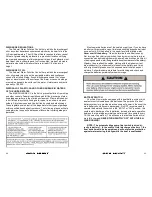
48
To drain other lines, close seacocks and run the pumps until the
lines are empty. After emptying the lines, re-open the seacocks. In
warmer climates draining will help prevent water stagnation.
FUEL SYSTEM
Fill your fuel tank with fuel to minimize space in the tank for con-
densation to form. Add a good quality fuel stabilizer, following the
manufacturer’s directions on the container.
DO NOT fill your tank
with fuel containing ethanol for storage!
The ethanol will tend to
separate out of the fuel over time, and will also absorb water.
BATTERIES
Check the electrolyte level in your batteries and fully charge the
batteries before storing. A weak battery loses its charge more rapidly
than a strong battery. Ideally, you should disconnect the batteries and
cover the terminals with grease to prevent corrosion.
When replacing batteries in the boat remove excess grease from
terminals and charge as necessary before reinstalling.
ENGINES
Check your engine owner’s manual regarding the procedures for
winterizing the engines. Follow these important instructions carefully,
and your engines should survive most weather conditions. Change all
filters. Check hoses and clamps. If you have any vibrations during the
season look for loose engine bolts, bent shafts or bent propellers.
STORAGE CHECKLIST
In addition to the winterization guidelines, use the following checklist
as a guide for storing your boat. Additional details should be added
as needed for your personal application.
Remove all loose items and personal effects.
Remove any detachable and valuable equipment such as elec-
tronics. Store electronics inside in a dry and secure place.
A built-in compass should be covered. Ultraviolet rays from the
sun will “cloud” the compass and make it difficult to read.
All equipment should be winterized as directed in the manufac-
turer’s manuals.
Winterize engine
Winterize fuel system
Winterize Raw / Fresh water systems.
Inspect & Lubricate trailer bearings and other recommended by
the trailer manufacturer.
17
SUGGESTED BOATING CLASSES AND LITERATURE
Boats must be operated according to prescribed safety rules and
traffic regulations. This manual contains basic boating tips and is not
intended as a substitute for a complete review of the safety rules and
regulations. We recommend you consult the following agencies for
further recommendations on safe boating and instructional classes:
United States Coast Guard,
United States Coast Guard Auxiliary,
United States Power Squadrons.
Additional boating knowledge can be obtained from some of the fol-
lowing periodicals:
PILOTING, SEAMANSHIP AND SMALL BOAT HANDLING
(Chapman) Motor Boating and Sailing
Post Office Box 2319 —F.D.R. Station
New York, New York 10022
Available on CD ROM or as book.
PLEASURE BOATING AND SEAMANSHIP
(US Coast Guard Auxil-
iary)
306 Wilson Road
Oaklands Newark, Delaware 19711
BOATMAN’S HANDBOOK
by Tom Bottomly
Post Office Box 2319 —F.D.R. Station
New York, New York 10022
For more information on BOATING SAFETY courses in your area,
call BOATING EDUCATION HOTLINE 1-800-336-BOAT (2628), US
COAST GUARD BOATING HOTLINE 1-800-368-5647 or contact your
local COAST GUARD.
















































